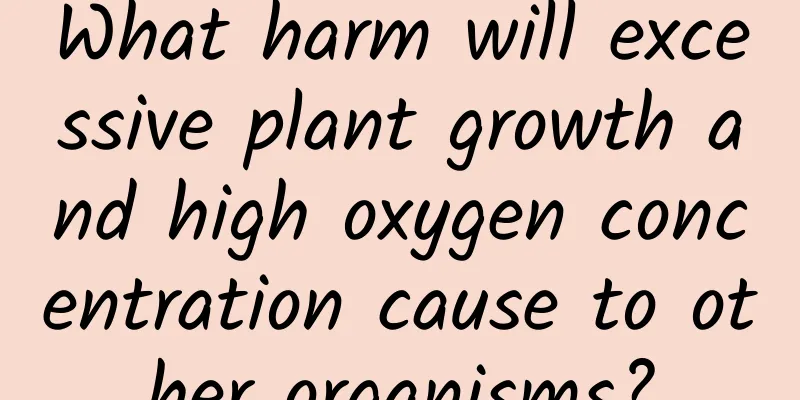What harm will excessive plant growth and high oxygen concentration cause to other organisms?

|
Oxygen was formerly known as "nourishing air". As the name suggests, it is the gas that nourishes us. Oxygen is a necessary substance for all things in the world to survive. If humans do not breathe, they will die in a few minutes. But in fact, too high a concentration of oxygen is indeed harmful to organisms. Aerobic respiration is essentially a slow oxidation reaction, while combustion is a violent oxidation reaction. Therefore, aerobic respiration can be regarded as a slow "combustion" that will eventually burn out the organism. In geological history, two mass extinction events were related to the prosperity of oxygen-producing organisms such as plants or excessive oxygen concentrations. Great Oxidation Event The Great Oxidation Event, also known as the "oxygen catastrophe," refers to the large-scale extinction of early anaerobic organisms during the process of the change from no to something oxygen in the atmosphere. About 3.8 billion years ago, the earliest life forms were born in an environment on Earth where there was almost no oxygen at the time. They were mainly anaerobic organisms, including archaea and true bacteria. Archaea The earliest oxygen-producing organisms, cyanobacteria, appeared 3.5 billion years ago. It should be noted that cyanobacteria are not plants, but more accurately called cyanobacteria. Cyanobacteria are oxygen-producing prokaryotes, while plants are oxygen-producing eukaryotes. The oxygen produced by cyanobacteria oxidized all the reducing substances that were everywhere on the earth at that time, mainly divalent ferrous ions. This took a full billion years. Legacy of the Great Oxidation: Iron Ore (ferric iron precipitates formed by oxidation of ferrous ions by oxygen) By about 2.4 billion years ago, free oxygen began to be released, and the concentration of oxygen in the atmosphere rose from almost nothing to 4% (today it is 21%) over a few hundred million years. The Great Oxidation Event: Phase 2 The harm of oxygen lies in the intermediate oxygen free radicals produced in the oxidation reaction, which can destroy biofilms and genetic material DNA. Anaerobic archaea were almost wiped out in this oxygen disaster. Before the Great Oxidation Event, archaea were the dominant life form on Earth, but today, we can only see traces of archaea in some extremely oxygen-deficient submarine volcanic vents and the bottom of highly concentrated salt lakes. Some archaea survived and developed the ability to repair DNA. They gradually developed a protective nuclear membrane and thus had a cell nucleus. These were the most primitive eukaryotes and the common ancestors of all fungi, plants, animals and humans today. Eukaryotic organisms: Algae cells About 21 years ago, this group of primitive eukaryotes engulfed an aerobic bacterium and eventually formed an internal symbiosis. The mitochondria thus settled inside the eukaryotic cells. From then on, eukaryotes began to live an aerobic life and began to evolve at an accelerated pace. Archaea reproduce by binary fission. The original cell divides into two, and the two newly formed cells are exactly the same as the original one. In this sense, as long as they can keep dividing, they are immortal. The respiratory center of eukaryotes: mitochondria In order to reduce the adverse effects of oxygen destroying genetic material, eukaryotic organisms have developed a gene recombination mechanism, that is, sexual reproduction, where offspring are different from their parents. Under the damage of oxygen free radicals, every eukaryotic individual will eventually age and die. Therefore, the emergence of oxygen promoted the evolution of life forms towards higher and more complex directions, but shortened the length of life. Late Devonian mass extinction The second disaster that occurred during the oxygen-rich era was the mass extinction event in the late Devonian period. Since the Ordovician period, plants and arthropods have landed one after another. At that time, there were no animals on Earth that fed on living plants, and animals could only eat other animals or the debris of dead plants and animals. This led to the excessive spread of plants over more than 200 million years, and by the late Devonian period (377 to 359 million years ago), primeval forests had formed worldwide. Due to the prosperity of land plants, the oxygen content in the atmosphere increased dramatically. Devonian forests and arthropods In the early days of the Earth, there was no soil on land. Plants acted on rocks to decompose soil, which was rich in inorganic salts needed for plant growth, promoting further growth of plants. These inorganic salts were washed into the ocean, causing algae to grow wildly, leading to eutrophication of water bodies and consuming oxygen in the ocean. Eutrophication of water bodies In this way, the atmosphere was rich in oxygen in the late Devonian period, but the ocean was oxygen-deficient, and a large number of marine animals died of suffocation. Dunkleosteus, 6-7 meters long, is a type of placoderm, the dominant fish in the Devonian period. Placoderms were the dominant fish in the Devonian period, and all became extinct in the late Devonian period. During the 20 million-year period of the late Devonian period, the land was full of life, but the ocean was a hell. A group of fish called crossopterygii were unwilling to sit and wait for death in the ocean, so they grew lungs and limbs that could move on land. Finally one day, they succeeded in landing. This is the earliest tetrapod, Ichthyostega, the common ancestor of today's amphibians, reptiles, birds, mammals and humans. Oxygen cooling effect Another effect of plants, cyanobacteria and the oxygen they produce on the Earth's environment is cooling. The early Earth's atmosphere had a high content of methane, a very efficient greenhouse gas, which ensured that the Earth could maintain a high temperature even when the sunlight was dim in the early days, thus nurturing life. Oxygen oxidizes methane into carbon dioxide, which is not as efficient as the former as a greenhouse gas. Plants can absorb carbon dioxide and release oxygen, which forms a positive feedback loop, resulting in higher and higher oxygen content in the atmosphere and lower and lower methane and carbon dioxide content, cooling the earth. Both the Great Oxidation Event and the Late Devonian Extinction Event saw severe cooling that froze the Earth into a snowball. The formation of polar glaciers will cause the earth's sea level to drop, exposing the continental shelf on which shallow marine life depends to the sea surface, which is fatal to shallow marine life. This is the reason why a large number of coral reefs disappeared in the late Devonian period. Summarize Everything has two sides, and oxygen is no exception. On the one hand, it provides all living things with free energy that can be used everywhere, promotes the evolution of life, and makes the world more colorful. On the other hand, its oxidizing property causes aging and death of organisms, and excessively high concentrations of oxygen will cause serious damage to organisms in a short period of time, which is medically known as "oxygen intoxication." Because of oxygen, the length of our lives is shortened, but we live more wonderfully. |
<<: "There was a cloud made of rain in the wind." What are clouds made of?
Recommend
Coca-Cola Marketing Law
When you see this billboard , can you recognize w...
Cold wave and strong wind warning! my country is experiencing a sharp drop in temperature from north to south. Has your "long johns DNA" changed?
The Central Meteorological Observatory continues ...
How did VIPKID build a customer acquisition system with a 70% referral rate?
VIPKID is the fastest growing online English educ...
Practical tips for operators and promoters: practical SEO optimization and promotion plans!
I believe that many friends who are new to SEO wi...
National Scallion Geography
Written by Wei Shuihua Header Image | Daily Food ...
How did the exposure rate of millions of levels come about?
In this era where everyone is a media, the audien...
Electric vehicle industry circle of friends advertising marketing strategy
1. Market background analysis Market development ...
Have you ever seen a bird that can set fire? Don't be the scapegoat for wildfires, maybe it used fire earlier than humans
Today we are going to talk about birds that trave...
Mobile app development trends you must know in 2020
Preface In today's Internet trend, it is not ...
How to build a GuangDianTong information flow account?
Guangdiantong is an advertising platform based on...
Online consumer finance product customer acquisition and operation methodology
After the beginning of spring, the weather is gra...
Is purified water not suitable for long-term drinking? See what experts say
Rumor: "Long-term drinking of purified water...
Interesting business strategy gameplay!
Business strategies are not standardized products...
Nine tech gadgets you can implant in your body
Given the crazy hype surrounding Apple's intr...









